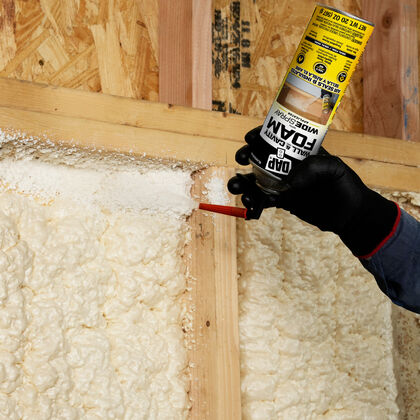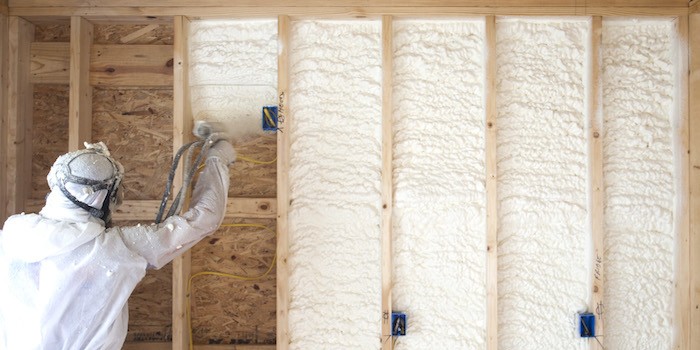Spray Foam: The Ultimate Remedy for Air Sealing and Insulation
Spray foam insulation has arised as a leading remedy for effective air sealing and thermal insulation, supplying a special mix of homes that set it aside from typical methods. Its capability to increase and fill up spaces makes it particularly reliable in stopping air leakage, which can substantially influence energy efficiency. Recognizing the full extent of its advantages, setup procedures, and comparisons with other insulation kinds is vital for making informed choices. As we discover these aspects, the implications for both new building and constructions and retrofits become increasingly substantial. What aspects should affect your selection?
What Is Spray Foam?
Spray foam is a versatile insulation material that combines the principles of air securing and thermal resistance to improve energy efficiency in structures. Composed mainly of polyurethane or various other similar compounds, spray foam is used as a liquid that increases upon call with surface areas, creating a solid, continual layer of insulation. This one-of-a-kind building enables it to load voids, splits, and spaces that traditional insulation products might overlook, giving a premium air seal.
There are two major kinds of spray foam: open-cell and closed-cell. Open-cell spray foam is lighter and much more flexible, providing excellent noise absorption and a reduced R-value per inch - Spray Foam. In comparison, closed-cell spray foam is denser, providing a higher R-value, wetness resistance, and included architectural stability to developing parts
The application procedure usually entails customized tools, ensuring a smooth application that follows different substratums, consisting of concrete, timber, and metal. This flexibility makes spray foam suitable for both new building and constructions and retrofitting existing frameworks. Its ability to produce an impermeable obstacle significantly adds to lowering power intake and improving indoor air high quality, consequently making it a recommended selection among home builders and house owners alike.
Benefits of Spray Foam Insulation
One of the most considerable advantages of spray foam insulation is its outstanding capacity to develop a continual air obstacle, which successfully lessens power loss. Unlike standard insulation products, spray foam broadens to fill up spaces and fractures, ensuring that air leakage is significantly reduced. This characteristic not just boosts power effectiveness yet additionally results in lower utility expenses gradually.
Furthermore, spray foam insulation gives premium thermal resistance, adding to a much more steady indoor setting. Its high R-value per inch enables efficient insulation in confined spaces, making it excellent for attic rooms, walls, and crawl spaces. In addition, the moisture-resistant residential or commercial properties of spray foam aid stop mold and mildew development, promoting much healthier living conditions.
One more crucial advantage of spray foam insulation is its sound-dampening high qualities (Spray Foam). It effectively minimizes noise transmission in between rooms, producing a quieter and more comfy home environment. The longevity of spray foam likewise sticks out, as it does not droop or clear up with time, maintaining its efficiency throughout its lifespan
Exactly How Spray Foam Works
Comprehending exactly how spray foam insulation functions is necessary for appreciating its performance in air sealing and thermal resistance. Spray foam insulation contains 2 primary parts: isocyanate and polyol resin. When these elements are combined, they undergo a chain reaction that creates the material to broaden swiftly, developing a thick foam that fills spaces, splits, and cavities.
As the foam broadens, it adheres to surface areas, creating an impermeable seal that dramatically lowers air seepage. This particular makes spray foam insulation extremely reliable at protecting against drafts and moisture penetration, which can lead to power loss and damages over time. In addition, the closed-cell version of spray foam uses superior thermal resistance due to its inflexible framework, effectively reducing warmth transfer.
The one-of-a-kind buildings of spray foam enable it to adapt irregular surface areas, making certain thorough protection and a seamless barrier. Therefore, spray foam insulation not just enhances energy effectiveness but additionally adds to boosted indoor air quality by decreasing the build-up of allergens and contaminants. Ultimately, recognizing the technicians behind spray foam highlights its function as an exceptional choice for insulation and air securing in both business and household applications.
Installation Process Overview

Before setup, the room should be effectively cleaned and prepped, ensuring that surface areas are devoid of debris, moisture, and dust. Since pollutants can jeopardize bond and general efficiency, this action is vital. As soon as the location is prepared, the application entails blending both parts of the spray foam, which increases upon call and loads voids properly.
Educated specialists need to perform the installment, using specific devices to make sure uniform coverage and optimal density. Safety and security preventative measures, consisting of putting on protective equipment and guaranteeing appropriate ventilation, are important throughout this procedure. After application, the foam normally treatments promptly, forming a strong obstacle that boosts power efficiency.
Comparing Spray Foam to Typical Insulation
When examining insulation options, spray foam insulation stands out in contrast to traditional products such as fiberglass and cellulose. Unlike fiberglass and cellulose, which can allow air seepage, spray foam expands upon application, filling up gaps and gaps to develop an airtight seal.
In addition, spray foam offers a greater R-value per inch than traditional insulation kinds, supplying more reliable thermal resistance in a thinner profile. This characteristic is specifically advantageous in rooms with limited tooth cavity deepness. Furthermore, spray foam is resistant to dampness Resources and mold growth, which can be a considerable worry about cellulose and fiberglass, especially in damp settings.
Nevertheless, spray foam insulation normally lugs a higher upfront expense than its typical equivalents. Homeowners should evaluate this first financial investment versus lasting energy savings and performance benefits. Ultimately, while both insulation types serve their function, spray foam emerges as a much more sophisticated option for modern-day insulation demands, specifically in regards to air securing and thermal performance.

Verdict
In recap, spray foam insulation stands for an extremely efficient service for achieving optimum air securing and thermal resistance. Its special buildings, consisting of wetness resistance and sound dampening, make it suitable for numerous applications in both brand-new buildings and retrofitting projects (Spray Foam). The first expenses may be greater compared to typical insulation materials, This Site the long-term advantages, such as significant power cost savings and boosted indoor air quality, validate the investment and highlight its value in contemporary building methods.
Spray foam insulation has emerged as a leading option for effective air securing and thermal insulation, offering an one-of-a-kind combination of homes that establish it apart from typical techniques.Spray foam is a versatile insulation material that incorporates the concepts of air securing and thermal resistance to improve power effectiveness in buildings.When examining insulation options, spray foam insulation stands out in contrast to standard materials such as fiberglass he has a good point and cellulose. Ultimately, while both insulation types serve their function, spray foam emerges as a much more advanced option for contemporary insulation demands, specifically in terms of air securing and thermal efficiency.
In summary, spray foam insulation stands for a very effective option for attaining optimal air sealing and thermal resistance.